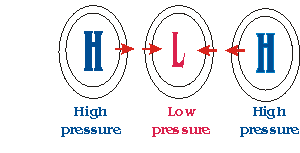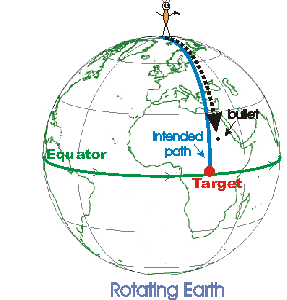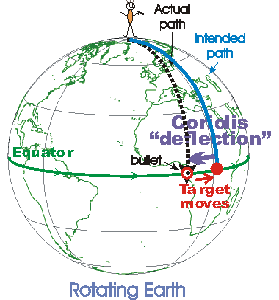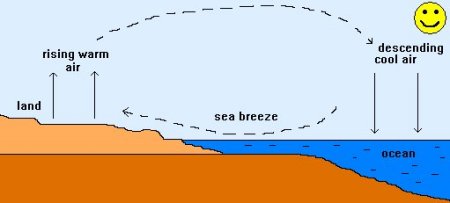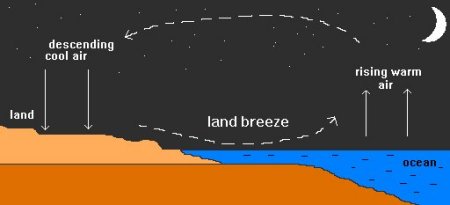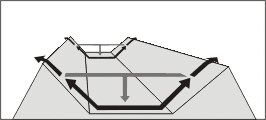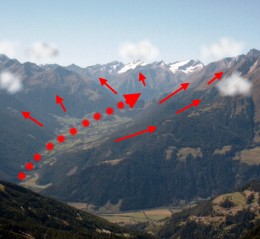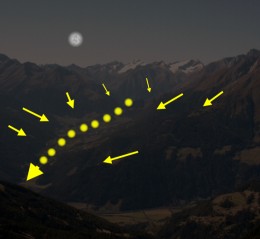 > English > Climate Encyclopaedia > Weather > basics > 2. Circulation Systems > - Local Circulation
> English > Climate Encyclopaedia > Weather > basics > 2. Circulation Systems > - Local Circulation
|
WeatherBasics |
Local Circulation |
|
Why does air circulate and what are the driving forces for this movement?
|
Energy from the Sun heats different parts of the Earth differently and this causes pressure differences to develop across the globe. These pressure differences cause air to move. The air moves from regions of high pressure to regions of low pressure to try to smooth out the pressure differences. Air movement occurs on different scales, on a global scale (global circulation of the Earth), over a medium scale (tornadoes) and on a local scale (mountain winds). In some zones around the Earth, the winds blow predominantly in one direction and this is known as the prevailing wind direction. This direction can change with the seasons. Winds over most areas are variable in direction from day to day. A wind is named according to the point of the compass from which it blows, i.e., a wind blowing from the north is a north wind.
|
|
|
Energy from the Sun is the most important driving force for winds but there are other forces, which are also important:
|
|
1. Pressure Gradient Force (PGF) - this causes horizontal pressure differences and winds.
|
|
We know that winds are generated by differences in air pressure. The greater the difference in pressure, the stronger the force. The distance between the area of high pressure and the area of low pressure also determines how fast the moving air is accelerated. Meteorologists refer to the force that starts the wind flowing as the "pressure gradient force".
|
|
2. Gravity
|
|
|
|
|
4. We experience centrifugal force when we ride on a merry-go-round, when we go round a curve in a car or when we make a sharp turn on a bike.Photo by Patricia Marroquin © http://www.betterphoto.com/gallery/ |
Land and Sea BreezesWater has a much greater heat capacity than land and, as a result, it warms up slower than the land and also cools down slower. So during the day, there are significant temperature differences between a water body such as a lake or the sea and the surrounding ground. This temperature difference causes pressure differences and, as a result, the development of local winds. Close to the coast, these winds are known as the sea breeze.
|
|
A sea breeze develops on sunny days when the land becomes much warmer than the sea. As the land warms up, the air above it expands and begins to rise. To replace the rising air, cooler air is drawn in from above the sea surface.
|
|
At night the water cools down slower than the land and the air circulation reverses and air moves from the land to the sea. This is called a land breeze.
|
Mountain and Valley BreezesSpecial wind systems develop in mountainous regions. The slopes of the mountains and the narrow parts of the valley are more intensively heated by the Sun than the open valley floor. This leads to the generation of valley breezes during the day and mountain breezes during the night.
|
|
|
|
So slope winds go up the mountains in the day and down during the night and the moving air has to be replaced with air from elsewhere. A simplified picture of the air circulation is shown in Figure 8. However, this slopewind circulation is only seen for a short time during the day. The air circulation in a typical valley is a bit more complicated than this!
|
|
The narrower the valley is, the more air that rises. This rising air is replaced from the valley floor or the plains. So the wind during the day usually comes from the lower and flatter parts of the valley system and then rises up the mountains. As the name of the wind is always given by the place or direction from where it comes from, we call this wind the valley breeze. During the night, the air cools and descends along the mountain slopes into the valley. So the breeze moves in the opposite direction, it comes from the mountains and moves into the valley floor and plains. As a result, this wind is known as the mountain breeze. |
|
|
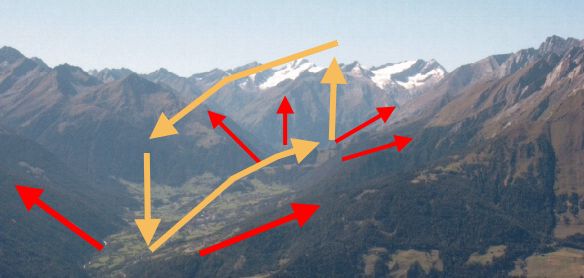 |
|
10. Local circulation during a valley breeze.This local circulation scheme is a bit simplistic as mountains are not smooth and have many side valleys. However, this gives a basic idea of the wind movement in a mountainous area.
|
Authors: Vera Schlanger & Szabolcs Bella - Hungarian Meteorological Service
|
Further reading:http://www.infoplease.com |


